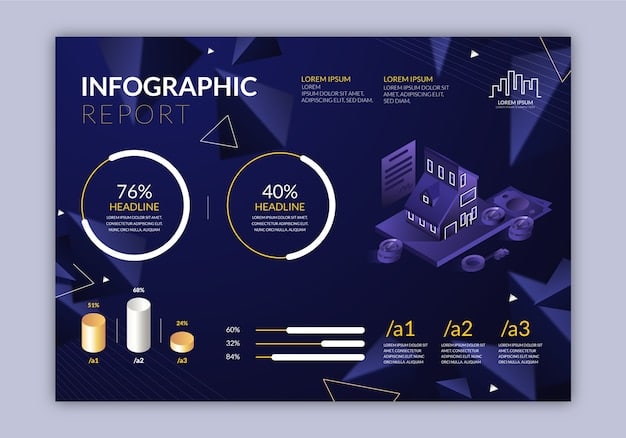How 3.2% Inflation Impacts Your Retirement Savings

Anúncios
The current 3.2% inflation rate for Americans can erode the purchasing power of retirement savings, making it crucial to adjust investment strategies and financial planning to maintain future living standards.
Anúncios
The specter of inflation consistently looms over financial planning, and understanding how the current inflation rate of 3.2% affects your retirement savings is paramount. It’s not just an abstract economic indicator; it’s a tangible force that can diminish your future purchasing power if left unaddressed. This article delves into the precise mechanisms through which even seemingly moderate inflation can erode your hard-earned nest egg, offering insights and actionable strategies to safeguard your financial future.
Understanding the Mechanics of Inflation and Its Impact on Retirement
Inflation, in essence, is the rate at which the general level of prices for goods and services is rising, and consequently, the purchasing power of currency is falling. When we talk about a 3.2% inflation rate, it means that, on average, the goods and services that cost $100 last year now cost $103.20. While 3.2% might seem modest compared to higher inflation periods, its cumulative effect over decades can be profound, especially for long-term goals like retirement.
The Silent Erosion of Purchasing Power
The primary mechanism through which inflation impacts retirement savings is the erosion of purchasing power. The dollars you accumulate today will buy less tomorrow. This isn’t just about everyday expenses; it extends to healthcare, housing, and leisure activities, all of which tend to increase in cost over time. A dollar saved today is effectively worth less when you finally retire if inflation is at play. This necessitates a careful re-evaluation of how much capital is truly needed in retirement.
Anúncios
Consider a simple scenario: if you aim to have $1 million saved for retirement, and inflation averages 3.2% annually, that $1 million will feel more like ~$500,000 in terms of purchasing power after about 20 years. This substantial reduction means your lifestyle expectations might need to be significantly adjusted unless your savings grow at a rate that outpaces inflation. This requires a dynamic approach to investment, moving beyond static savings accounts.
Real vs. Nominal Returns
Understanding the difference between real and nominal returns is critical. Nominal returns are the stated returns on your investments before accounting for inflation. Real returns, however, reflect the actual increase in your purchasing power after inflation has been factored in. If your investment earns a 5% nominal return, but inflation is 3.2%, your real return is only 1.8%. This seemingly small difference can lead to a significant shortfall in your retirement funds over time. It underscores the importance of choosing investments that can consistently deliver returns above the prevailing inflation rate, maintaining and even increasing your real wealth.
The long-term nature of retirement planning makes it particularly vulnerable to the compounding effect of inflation. Even a seemingly small annual inflation rate can significantly reduce the ultimate value of a retirement portfolio, demanding a proactive and informed strategy from savers. It’s not enough to simply save; one must save with an awareness of the changing economic landscape.
Assessing the Vulnerability of Your Retirement Accounts
Different types of retirement accounts and investment vehicles respond to inflation in varied ways. Understanding these sensitivities is crucial for optimizing your retirement strategy in an inflationary environment. Some accounts offer inherent protections, while others might require more active management to mitigate inflation’s bite.
Traditional IRAs and 401(k)s
Traditional IRAs and 401(k)s offer tax-deferred growth, meaning contributions and earnings aren’t taxed until retirement. While this is a significant advantage, the investments held within these accounts are still subject to inflation’s effects. If your portfolio primarily consists of fixed-income assets like bonds or cash equivalents that yield less than 3.2%, your purchasing power will decline over time. The tax deferral itself doesn’t insulate the underlying assets from inflationary pressures. Reviewing your asset allocation periodically is therefore essential to ensure your investments are striving to beat inflation.
Roth IRAs and 401(k)s
Roth accounts are tax-free in retirement, as contributions are made with after-tax dollars. This tax-free withdrawal feature can be a powerful hedge against inflation, particularly if tax rates rise in the future due to inflationary pressures or other economic factors. However, similar to traditional accounts, the investments within a Roth must still outperform inflation for your real wealth to grow. The tax benefit protects the income stream from future tax liabilities, but not directly from the loss of purchasing power of the underlying assets if they don’t keep pace with rising costs.
Pension Plans and Annuities
Pension plans and annuities can offer a degree of predictability, but their inflation protection varies significantly. Some defined-benefit pension plans offer cost-of-living adjustments (COLAs) that are tied to inflation, providing a critical buffer. Others may have fixed payments, which will steadily lose purchasing power as inflation persists. Annuities can be structured with inflation riders, but these often come at a higher cost. It’s vital to scrutinize the terms of any pension or annuity to understand its inflation-hedging capabilities. Without strong COLA provisions, these income streams can be very susceptible to long-term inflationary erosion.
Cash and Certificates of Deposit (CDs)
Holding significant amounts of cash or investing heavily in low-yielding CDs is particularly detrimental during periods of inflation. Unless their interest rates match or exceed the inflation rate, which is currently 3.2%, your money is guaranteed to lose purchasing power. While liquidity is important, excessive cash holdings can act as a drag on your retirement savings, especially now.
- Cash offers no growth, only loses value.
- CDs typically offer fixed rates, often below inflation.
- Maintaining adequate liquidity without over-allocating is key.
Understanding these distinctions allows for a more nuanced approach to portfolio construction. It emphasizes the need to look beyond the account type and focus on the underlying investments’ real return potential. The goal is not just to accumulate dollars, but to accumulate purchasing power that will sustain you throughout your retirement years.
Strategies to Mitigate Inflation’s Impact on Retirement Savings
To counteract the erosive effects of a 3.2% inflation rate on your retirement savings, a proactive and diversified strategy is essential. No single solution guarantees complete immunity, but a combination of well-considered approaches can significantly bolster your portfolio’s resilience. The aim is to ensure your investments are configured for growth that consistently outpaces the rising cost of living.
Invest in Growth-Oriented Assets
Historically, equities (stocks) have proven to be one of the most effective long-term hedges against inflation. Companies can often pass increased costs onto consumers, and their earnings and dividends may grow over time, providing a natural inflation buffer. While stocks carry more risk than fixed-income assets, their potential for capital appreciation and dividend growth makes them a critical component of an inflation-resistant portfolio. Diversification across various industries and market caps can further reduce risk.
Consider diversifying your equity portfolio to include:
- Companies with strong pricing power: Businesses that can easily raise prices without losing customers.
- Companies that benefit from rising commodity prices: Example sectors include energy and materials.
- International markets: Diversifying geographically can capture growth in different economic cycles.
Consider Inflation-Protected Securities (TIPS)
Treasury Inflation-Protected Securities (TIPS) are U.S. Treasury bonds whose principal value adjusts with the Consumer Price Index (CPI), making them an effective direct hedge against inflation. When inflation rises, the principal value of TIPS increases, and the interest payments are then paid on this adjusted principal. While their yield may be lower than traditional bonds, the protection they offer against purchasing power erosion can be invaluable in an inflationary environment. They provide a guaranteed real return, though modest.
Evaluate Real Estate and Commodities
Real estate, particularly income-generating properties or REITs (Real Estate Investment Trusts), can serve as an inflation hedge. Property values and rental income tend to increase with inflation. Commodities like gold, silver, and other raw materials also historically perform well during inflationary periods, as their prices often rise in tandem with general price levels. However, these assets can be volatile and require careful consideration of their role within your overall portfolio due to their inherent risks and less predictable income streams compared to traditional investments.

Review Your Asset Allocation Regularly
An investment strategy that worked a decade ago may not be suitable today, especially with shifting economic landscapes. Regular review and rebalancing of your asset allocation are paramount. This involves adjusting the proportion of different asset classes in your portfolio to ensure it remains aligned with your risk tolerance, time horizon, and inflation outlook. As your retirement date approaches, you might gradually shift from more aggressive growth assets to more stable, income-generating ones, though still maintaining some inflation protection. For many, a balanced portfolio that includes a mix of equities, fixed income, and inflation-protected assets is often recommended to weather various market conditions.
The overall goal is not just to grow your nominal wealth, but to actively grow your real wealth, ensuring that when you do retire, your savings can truly support the lifestyle you envision. This requires continuous monitoring and adaptation to economic shifts like the current 3.2% inflation rate.
Adjusting Your Retirement Income Strategy for Inflation
Inflation doesn’t just affect your accumulated savings; it also dictates the purchasing power of your retirement income. A well-constructed income strategy must account for the ongoing erosion of money’s value. For retirees, or those nearing retirement, this requires a shift from accumulation to managing withdrawals effectively.
The “Safe Withdrawal Rate” Debate
The traditional “4% rule” for safe withdrawal rates, suggesting you can withdraw 4% of your portfolio’s value in the first year of retirement and adjust it for inflation annually, has been a cornerstone of retirement planning. However, in an environment of 3.2% inflation, and potentially higher future inflation, this rule comes under scrutiny. A higher inflation rate means that annual increase in withdrawals needs to be larger, putting more pressure on the portfolio’s longevity. Some financial planners are advocating for lower initial withdrawal rates (e.g., 3-3.5%) or more flexible, dynamic withdrawal strategies that adjust based on market performance and inflation. This proactive adjustment can significantly extend the life of a retirement fund.
Alternative withdrawal strategies include:
- Guardrail Method: Adjusting withdrawals up or down based on predefined portfolio performance thresholds.
- CPI-Adjusted Withdrawals: Directly linking annual withdrawal increases to the Consumer Price Index, ensuring purchasing power is maintained.
- Time-Segmentation (Bucket Strategy): Allocating funds into different “buckets” for short-term, medium-term, and long-term needs, with short-term funds in less volatile assets and long-term funds in growth-oriented assets.
Considering Social Security and COLA
Social Security benefits include annual cost-of-living adjustments (COLAs), which are designed to help benefits keep pace with inflation. These adjustments are typically tied to the CPI. While Social Security may not cover all your retirement expenses, its COLA mechanism provides a valuable base layer of inflation-adjusted income. Understanding how the Social Security COLA is calculated and how it might impact your overall retirement income stream is crucial for accurate financial forecasting. It provides a fixed, albeit limited, hedge against rising prices.
Part-Time Work and Delayed Retirement
Beyond investment strategies, behavioral adjustments can also play a significant role. If inflation is eroding your savings faster than anticipated, considering part-time work in early retirement or delaying retirement by a few years can provide crucial benefits.
- It allows your existing savings more time to grow and recover.
- It reduces the number of years you’ll be drawing down your portfolio.
- It provides additional income that can offset inflationary pressures on expenses.
This flexibility can be a powerful tool, providing a sense of financial security that a fixed portfolio withdrawal might not offer during inflationary times. It also allows individuals to contribute more to their retirement accounts, leveraging more time for compounding returns.
Ultimately, a robust retirement income strategy requires flexibility and an awareness of economic realities. As inflation fluctuates, so too should your approach to managing your income streams. Proactive planning is the best defense against unforeseen economic shifts.
The Psychological and Emotional Toll of Inflation on Retirees
Beyond the purely financial implications, inflation can exert a significant psychological and emotional toll, particularly on those in or nearing retirement. The uncertainty and erosion of purchasing power can lead to stress, anxiety, and a sense of diminished control over one’s financial future.
Anxiety Over Future Living Standards
One of the most immediate emotional impacts of inflation is the anxiety it generates regarding future living standards. Retirees often envision a certain quality of life—travel, hobbies, comfortable housing. When inflation increases, these aspirations feel threatened. The fear that current savings might not be enough to sustain the desired lifestyle can be profoundly unsettling. This concern can lead to obsessive checking of investment performance or a reluctance to spend, even on necessary items, out of fear of outliving one’s money. This constant worry can diminish the enjoyment of what should be a period of relative ease and freedom.
Loss of Control and Financial Insecurity
Inflation, especially when it feels persistent or unexpected, can manifest as a loss of control. Many retirees have meticulously planned their finances for decades, only to see the value of their efforts chipped away by an external force they cannot directly influence. This can lead to feelings of financial insecurity, even for those with substantial savings. The perceived reduction in “real” wealth can lead to a sense of impoverishment, influencing spending habits and overall well-being. It highlights the importance of open communication with financial advisors and support networks to manage these anxieties effectively.
Impact on Healthcare and Daily Living Expenses
Healthcare costs are a significant expenditure for most retirees, and they tend to rise faster than general inflation. When coupled with a 3.2% inflation rate for overall goods and services, the impact on a fixed retirement income can be severe. This can force difficult choices, such as delaying medical procedures, cutting back on medications, or reducing discretionary spending to cover essential health needs. The daily increase in prices for groceries, utilities, and transportation can also create a constant low-level stress, making budgeting a daily challenge rather than a periodic exercise. This incremental erosion of buying power can be particularly frustrating and demoralizing as the ability to earn more income diminishes.

Addressing these psychological impacts is as important as managing the financial ones. Open communication with family, financial advisors, and possibly mental health professionals can help retirees navigate these emotional challenges. Understanding that inflation is a systemic issue, and implementing strategic financial adjustments, can help restore a sense of agency and alleviate some of the associated stress.
Long-Term Planning in an Inflationary Environment
Effective long-term planning for retirement in an inflationary environment requires more than just reacting to current rates; it demands foresight and adaptability. The 3.2% inflation rate, while a benchmark, should be viewed as part of a dynamic economic landscape that necessitates continuous adjustment of your retirement strategy.
The Power of Compounding Against Inflation
One of the most powerful tools in combating inflation is the power of compounding. The earlier you start saving and investing, the more time your money has to grow and generate returns that can outpace inflation. Even modest, consistent contributions, combined with inflation-beating investment returns, can result in a significantly larger nest egg over a multi-decade horizon. This long-term perspective is crucial, as the cumulative effect of inflation mitigation can far outweigh short-term market fluctuations.
Diversification Beyond Traditional Assets
While stocks and bonds form the bedrock of many portfolios, exploring diversification into alternative assets can provide additional inflation protection. This might include:
- Private Equity: Investing in unlisted companies that may experience growth independent of public markets.
- Infrastructure Investments: Assets like utilities, roads, or communication networks that often have stable cash flows and inflation-linked revenues.
- Managed Futures: Strategies that trade futures contracts across various asset classes, potentially benefiting from trends regardless of market direction.
These alternatives can offer unique risk/return profiles and low correlation with traditional asset classes, providing a more robust shield against inflation. However, they often come with higher fees, liquidity constraints, and require thorough due diligence.
Regular Financial Planning Check-ups
A static financial plan is a vulnerable one in an inflationary world. Regularly scheduled financial planning check-ups, ideally with a qualified financial advisor, are indispensable. These sessions should review not only your investment performance but also your spending habits, anticipated future expenses (especially healthcare), and the prevailing economic outlook. An advisor can help reassess your asset allocation, identify areas of vulnerability, and suggest adjustments to keep your retirement plan on track, accounting for factors like the 3.2% inflation rate. This iterative process ensures that your financial goals remain realistic and attainable given evolving economic conditions.
Long-term success in retirement planning amidst inflation hinges on continuous education, proactive decision-making, and a willingness to adapt. By embracing diverse investment strategies and maintaining vigilance over economic indicators, you can build a retirement portfolio designed to thrive, not just survive, in any inflationary environment.
Leveraging Technology and Resources for Retirement Planning
In today’s digital age, a wealth of technology and resources can empower individuals to better understand and manage the impact of inflation on their retirement savings. From online calculators to digital financial advisors, these tools offer accessibility and insights that were once limited to financial professionals.
Online Inflation Calculators and Projections
Numerous online calculators allow you to input the current inflation rate, your desired retirement income, and your current savings to project how much your money will be worth in the future. These tools can vividly illustrate the erosive power of inflation, helping you visualize the real purchasing power of your future dollars. They can also help estimate future expenses, like healthcare or education, allowing for more accurate retirement funding targets. This can be a wake-up call for many, prompting them to save more aggressively or adjust their investment strategies. Many financial institutions and government websites offer these free resources.
Robo-Advisors and Digital Planning Tools
Robo-advisors utilize algorithms to create and manage diversified investment portfolios tailored to your risk tolerance and financial goals. Many robo-advisors incorporate inflation expectations into their models, automatically rebalancing portfolios to maintain an optimal asset allocation designed to combat market forces, including a 3.2% inflation rate. For those who prefer a more hands-off approach or have smaller portfolios, these platforms offer an accessible and cost-effective way to get professional investment management, potentially outperforming self-managed portfolios.
These platforms often provide:
- Automated rebalancing to maintain target asset allocation.
- Tax-loss harvesting to optimize after-tax returns.
- Diversified portfolios across various asset classes, including those focused on inflation protection.
Educational Resources and Webinars
The internet is brimming with high-quality educational content on personal finance, investment, and retirement planning. Reputable financial news outlets, academic institutions, and financial literacy organizations offer articles, guides, and webinars often free of charge. Engaging with these resources can deepen your understanding of economic principles, investment strategies, and how to specifically address inflation’s challenges. Staying informed about economic trends and expert recommendations is a proactive step in protecting your retirement. This continuous learning ensures your financial decisions are based on current, relevant information.
By effectively leveraging these technological tools and educational resources, individuals can demystify the complexities of inflation and its impact on retirement savings. They empower proactive decision-making, transforming what could be a source of anxiety into an opportunity for informed action and more secure financial planning.
| Key Aspect | Brief Description |
|---|---|
| eroding Purchasing Power | Inflation at 3.2% means your money buys less over time, impacting future living costs. |
| Real vs. Nominal Returns | Focus on real returns to see if your investments truly grow after inflation. |
| Investment Strategies | Diversify into growth assets like equities and consider inflation-protected securities. |
| 💡 Planning Ahead | Regular financial check-ups and utilizing planning tools are essential for robustness. |
Frequently Asked Questions About Inflation and Retirement
A real return is the profit made on an investment after accounting for inflation. It’s crucial because it shows the actual increase in your purchasing power. If your nominal return is 5% and inflation is 3.2%, your real return is only 1.8%, meaning your money’s buying power only grew marginally.
Fixed-income investments generally suffer in inflationary environments if their yield is below the inflation rate. At 3.2% inflation, a bond yielding 2% will lose purchasing power. This erosion means the money you receive in interest (and principal) will buy less than when you initially invested.
The choice between Roth and Traditional accounts primarily hinges on your current versus future tax expectations. While a Roth IRA’s tax-free withdrawals in retirement can be beneficial if taxes rise due to inflation, the account type itself doesn’t directly beat inflation. The key is what assets are held within the account that generate real returns.
Historically, real estate and commodities have shown some ability to hedge against inflation. Property values and rental income can rise with general prices. Commodities also tend to increase in value. However, they can be volatile and should be considered as part of a diversified portfolio, not the sole solution.
The most important action is to review your current investment portfolio’s asset allocation. Ensure it includes enough growth-oriented assets (like equities) and potentially inflation-protected securities (TIPS) that have the potential to deliver real returns exceeding the 3.2% inflation rate over the long term. Consulting a financial advisor is highly recommended.
Conclusion
The current 3.2% inflation rate serves as a critical reminder that retirement planning is an ongoing, dynamic process. It’s not merely about accumulating a certain sum of money, but about preserving and growing your purchasing power to ensure a comfortable and sustainable retirement. By understanding how inflation erodes wealth, strategically diversifying investments to include growth-oriented assets and inflation hedges, and regularly reviewing your financial plan, you can build a robust defense against rising costs. Proactive engagement with your finances, leveraging available tools and expert advice, is the most effective way to safeguard your retirement savings against the silent, yet powerful, force of inflation.





